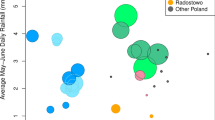Abstract
Pathotype frequencies in barley powdery mildew populations were assessed in artificially inoculated barley plots. The field experiment was organised in eighteen 3 m × 3 m plots with different inoculum compositions, obtained by sequential inoculation with three isolates, gl-1, gl-2 and gl-3, shortly after seedling emergence. In the conidia populations before summer, pathotypes corresponding to the inoculated isolates were detected at frequencies in the range 11–42% for GL1, 0–14% for GL2 and 2–34% for GL3. On the volunteers appearing after harvest these three pathotypes were observed at lower frequencies: 0–37% for GL1, 0–12% for GL2 and 0–23% for GL3. The overall ranking of GL1, GL2 and GL3 frequencies was thus the same before and after summer. The populations on volunteers were influenced by both sexual and asexual populations present in the same field at the end of the previous growing season. However, at the small-scale level no simple correlation was found between the frequencies in the conidia populations on volunteers and those in the airborne population, or the conidia populations on the crop before summer, or the calculated expected frequencies in populations of ascospores. During the summer survival, chance events may also have a large influence on pathotype frequencies leading to a high variation between repeated events of transition from the crop to the volunteers.
Similar content being viewed by others
References
Bousset L and de Vallavieille-Pope C (2003) Effect of sexual recombination on pathotype frequencies in barley powdery mildew populations of artificially inoculated field plots. European Journal of Plant Pathology 109: 13-24
Bousset L, Schaeffer B and de Vallavieille-Pope C (2001) Effect of early infection on pathotype frequencies in barley powdery mildew (Blumeria graminis f. sp. hordei) populations in field plots. Plant Pathology 50: 317-324
Brändle UE, Haemmerli UA, McDermott JM and Wolfe MS (1997) Interpreting population genetic data with the help of genetic linkage maps. In: Crute IR, Holub EB and Burdon JJ (eds) The Gene-for-Gene Relationship in Host-Parasite Interactions (pp 157-171) CAB International, Oxon
Brown JKM (2000) Estimation of rates of recombination and migration in populations of plant pathogens. Phytopathology 90: 320-323
Brown JKM and Simpson CG (1994) Genetic analysis of DNA fingerprints and virulences in Erysiphe graminis f. sp. hordei. Current Genetics 26: 172-178
Brown JKM, Le Boulaire S and Evans N (1996) Genetics of responses to morpholine-type fungicides and of avirulences in Erysiphe graminis f. sp. hordei. European Journal of Plant Pathology 102: 479-490
Brown JKM, Foster EM and O'Hara RB (1997) Adaptation of powdery mildew populations to cereal varieties in relation to durable and non-durable resistance. In: Crute IR, Holub EB and Burdon JJ (eds) The Gene-for-Gene Relationship in Host-Parasite Interactions (pp 119-138) CAB International, Oxon
Caffier V, Hoffstadt T, Leconte M and de Vallavieille-Pope C (1996a) Seasonal changes in pathotype complexity in French populations of barley powdery mildew. Plant Pathology 45: 454-468
Caffier V, de Vallavieille-Pope C and Brown JKM (1996b) Segregation of avirulences and genetic basis of infection types in Erysiphe graminis f. sp. hordei. Phytopathology 86: 1112-1121
Caffier V, Brändle U and Wolfe MS (1999) Genotypic diversity in barley powdery mildew populations in northern France. Plant Pathology 48: 582-587
Délye C and Corio-Costet MF (1998) Origin of primary infections of grape by Uncinula necator: RAPD analysis discriminates two biotypes. Mycological Research 102: 283-288
Hovmøller MS, Munk L and Østergård H (1993) Observed and predicted changes in virulence gene frequencies at 11 loci in a local barley powdery mildew population. Phytopathology 83: 253-260
Hovmøller MS, Østergård H and Munk L (1997) Modelling virulence dynamics of airborne plant pathogens in relation to selection by host resistance in agricultural crop. In: Crute IR, Burdon JJ and Holub EB (eds) The Gene-for-Gene Relationship in Host-Parasite Interactions (pp 173-190) CAB International, Oxon
Jørgensen JH (1988) Erysiphe graminis, powdery mildew of cereals and grasses. Advances in Plant Pathology 6: 137-157
Kølster P, Munk L, Stølen O and Løhde J (1986) Near-isogenic barley lines with genes for resistance to powdery mildew. Crop Science 26: 903-907
Liu Y-C, Cortesi P, Double ML, McDonald WL and Milgroom MG (1996) Diversity and multilocus genetic structure in populations of Cryphonectria parasitica. Phytopathology 86: 1344-1351
Moseman JG, Macer RCF and Greeley LW (1965) Genetic studies with cultures of Erysiphe graminis f. sp. hordei virulent on Hordeum spontaneum. Transactions of the British Mycological Society 48: 479-489
O'Hara RB and Brown JKM (1996) Immigration of the mildew pathogen into field plots of barley. Plant Pathology 45: 1071-1076
Smedegård-Petersen V (1967) Studies on Erysiphe graminis DC with a special view to the importance of the perithecia for attacks on barley and wheat in Denmark. Kønglisk Veterinaer-og Landbohøjskoles Årsskrift 1967: 1-28
Taylor JW, Jacobson DJ and Fisher MC (1999) The evolution of asexual fungi: reproduction, speciation and classification. Annual Review of Phytopathology 37: 197-246
Welz G and Kranz J (1987) Effects of recombination on races of a barley powdery mildew population. Plant Pathology 36: 107-113
Zhan J, Mundt CC and McDonald BA (1998) Measuring immigration and sexual reproduction in field populations of Mycosphaerella graminicola. Phytopathology 88: 1330-1337
Zhan J, Mundt CC and McDonald BA (2000) Estimation of rates of recombination and migration in populations of plant pathogens-a reply. Phytopathology 90: 324-326
Author information
Authors and Affiliations
Rights and permissions
About this article
Cite this article
Bousset, L., de Vallavieille-Pope, C. Barley Powdery Mildew Populations on Volunteers and Changes in Pathotype Frequencies During Summer on Artificially Inoculated Field Plots. European Journal of Plant Pathology 109, 25–33 (2003). https://doi.org/10.1023/A:1022073224259
Issue Date:
DOI: https://doi.org/10.1023/A:1022073224259




